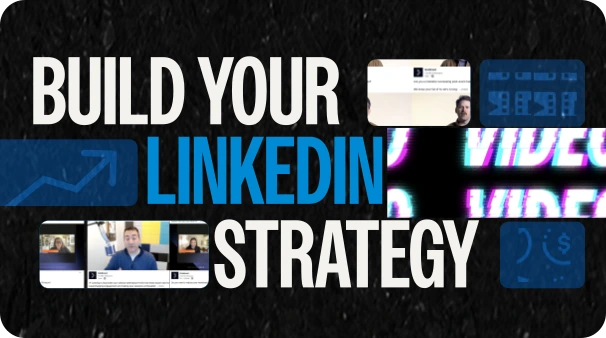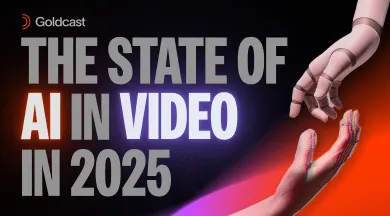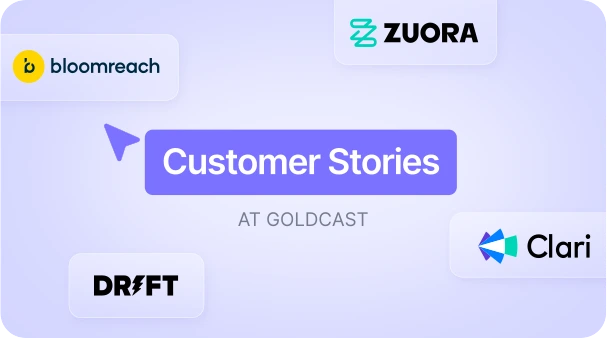Elevate Your Content Game with an Event-to-Multimodal Content Approach

Table of Contents
Maximize Your Marketing ROI
Join 10,000 other marketers already getting the best tips on running engaging events that boost pipeline and create raving fans.
Marketers, we have a question for you: How long does it take to make a three-minute video?
Of course, it depends on the video. There’s writing, storyboarding, interviewing, capturing B-roll — not to mention the editing and approval process. Most media agencies will give you a lead time of three to five weeks or longer.
Whether you’re investing internal resources or spending your budget on outsourcing, it can be hard to justify an investment in video — even when you know the final asset will be high value.
But we’ll let you in on a secret: Creating video content doesn’t have to be a budget-breaking endeavor. With the right tools and strategies, you can create a powerful, efficient content machine that starts with long-form video and spins out into a variety of formats.
We call it the multimodal content pipeline. What does this pipeline look like? Why start with video? How can you set yourself up for success? Read on to find out.
Advantages of building your multimodal content pipeline on video
First things first: What is a multimodal content pipeline? According to Kelly Cheng, Head of Marketing at Goldcast, multimodal content is a combination of text and video. “When looking at statistics,” Kelly explains, we know that “human beings prefer to consume messaging and content that is mixed. Pure text isn’t as appealing as text plus video, and text plus video plus images.”
Marketers are starting to deeply understand that video marketing isn’t only about marketing with video. It’s about getting the most out of videos by repackaging them into other formats. One of the best ways to set up a multimodal content pipeline that does the most is to start with video.
Why build your pipeline on video? Here are a few reasons.
Better engagement
Like a face-to-face conversation, video engages audiences in ways that text alone cannot. Combining audio with visual elements like animation, interviews, and B-roll immerses viewers and keeps them locked in longer.
And more engagement with your target audience also helps build your pipeline. Research by Wyzowl revealed that 84% of consumers have bought a product or service after watching a video about it.
In your quest to build a multimodal content strategy, it makes sense to start with video because you can separate these combined elements—audio, animations, talking heads—and repackage them in different ways while keeping engagement high. And this is especially true of your event video recordings.
Social sharing opportunities
At this point, we’re convinced that sending TikToks and Instagram Reels back and forth is a sixth love language. Video content is highly shareable compared to text and image-based posts. We’re not saying every video will go viral, but increasing your reach with the right audience doesn’t hurt.
When you use a longer-form video—e.g. a recording of a webinar you hosted—as the basis for your multimodal pipeline, you can repurpose the content into a wealth of other formats. Extract excerpts from the video to produce:
- Short snippets
- Quote graphics
- Bite-sized learning posts
- Infographics
The possibilities are endless, and the great part is, you’ve already done the hard work of creating the long-form video. All you have to do is splice it up (or enlist AI’s help to repurpose your video content).
Impact on SEO and conversions
Video content can boost SEO in a variety of ways:
- Earn you featured spots on the SERP—and more click-throughs
- Keep users engaged, leading to more time on site and conversions
- Attract backlinks from high-authority sites
Plus, videos are an amazing source of website content. From blog posts to white papers to testimonials, if you have it in a video, you’d better have it in a written format on your site. 📝
Mobile-friendly
In the past week, how many blog posts did you read on your phone? How many videos did you watch? Video content is just easier to consume on mobile than long-form text.
And today, as mobile accounts for 313% more visits than desktop, you can’t afford not to present content in formats consumable on mobile.
Starting your content pipeline with video helps you ensure your message is accessible across devices. Even a humble blog post can be engaging on a phone when it has short video clips and graphics sprinkled throughout.
Trust building
If a picture is worth a thousand words, how many words is a video worth? When it comes to showcasing your brand’s personality and human side, it’s a lot. Putting faces — or even animations — to names helps you build trust with your audiences.
Many of these “human” elements are exactly why video is so perfect for repurposing. Quotes from video interviews add credibility to blog posts. Behind-the-scenes footage is transformed into “sneak peek” social content.
It all works together to build a cohesive brand image that makes your audience feel like they know you on a personal level.
10 proven event-to-video-to-multimodal marketing strategies
Are you convinced that video is the GOAT foundation for your multimodal content pipeline? We thought you would be.
Now, the question is: How do you get from events ➡️ video ➡️ multichannel content? Here are a few key strategies.
1. Set your goals
Before you dive headfirst into content creation, it’s crucial to identify your goals. Some common goals could include:
- Increasing brand awareness
- Generating leads
- Educating your audience / moving them through the funnel
- Establishing thought leadership
- Increasing customer or audience engagement
Clarifying your goals from the outset will guide the creation process and keep you on track.
2. Define your target audience
If you create content for different audiences, be sure to note which one your new event content is intended for. Keep in mind factors like:
- Demos (job titles, industries, company sizes)
- Pain points and challenges
- Preferred content formats and platforms
- Stage in the buying journey
This targeted approach will help you tailor your content to your audience, improving engagement cross-platform.
3. Set your budget
There are plenty of ways to create excellent content on a budget — but you do need to know what that budget is starting out. To get a realistic idea of your budget, consider the costs associated with:
- Video production (equipment, talent)
- Content repurposing (editing, writing, graphic design)
- Distribution and promotion
Investing up-front in creating high-quality content is wise when you’re going to be extensively repackaging what you create. That quality will trickle downstream and save you time and resources as you create derivative assets.
4. Decide your creative direction
From your goals and target audience, you can start to form up a consistent creative direction for your content. Create a detailed event brief that lays out your visual elements, key messages, and storytelling approach.
Outlining these pieces will help all team members stay on the same page when creating your initial event content — ensuring consistency across all the content assets that come out of it.
5. Experiment with video formats
Consider experimenting with different video formats. This keeps your content fresh and engaging while also setting you up for success when repurposing your video down the line.
Some of our favorite formats to capture:
- Keynote presentations
- Panel discussions
- Interviews
- Behind-the-scenes footage
- Product demos
- Customer testimonials
Diversifying your video content creates a great experience for your event attendees and provides a wealth of material for your multimodal content strategy.
6. Repurpose videos
When your event is over, what’s next? You’re sitting on top of a gold mine of video footage, just waiting to be repurposed. Here are some of the highest-ROI ways to repurpose your event content for additional channels:
- Extract blog posts from video transcripts
- Create infographics from key statistics
- Develop social media snippets
- Create quote graphics from event speakers
- Craft email newsletter content
Of course, manually wading through event footage can be tedious. Luckily, AI has entered this scene. AI tools can streamline the content repurposing process — helping with transcriptions, summarizing content, and even brainstorming ideas for repurposing.
We created Goldcast Content Lab to do all this and more. Try it for free now.
7. Use multiple channels
The whole point of a multimodal content pipeline is to maximize the impact of your content. But identifying which channels will best accomplish this goal for your brand takes time. Consider:
- Social media platforms
- Email marketing
- Company blog
- Industry publications or guest posts
- Additional virtual events
Setting your content repurposing strategy at the beginning of the event planning process enables you to use many other channels without investing a lot more time or resources.
8. Track analytics
If we had one content tip to rule them all, it would be: Track 👏🏻 your 👏🏻 content’s 👏🏻 performance.
The right virtual event platform will give you a trove of analytics you can use to track engagement, conversions, and audience feedback. Use these insights to refine your content strategy and focus on what resonates most with your audiences.
Your event analytics can help you understand which content types and topics are most effective. Then, once you repurpose content for additional channels, you can turn to those platforms’ analytics to gauge the ROI of each channel.
9. Allocate program and media spend
Remember earlier when you set your budget? That third bullet, distribution and promotion, is crucial. If you use all your resources to create content, it won’t get far.
Try to balance organic and paid strategies to make sure your content reaches the right audience. Some paid media tactics to consider:
- Paid promotion on social
- Sponsored content in industry publications
- Retargeting campaigns
Even the best content can benefit from a few extra distribution dollars to achieve its full potential.
10. Use the right tools
Technology can help streamline the process of creating, repurposing, and distributing your content. Tools like video editors, social scheduling tools, content management systems, and analytics aggregators can improve your efficiency and help you scale your content efforts.
And here’s our pro tip: Be sure to check the tools you’re already using to see if they’ve recently added AI capabilities. A lot has changed in the content creation space in the past couple of years.
Incorporating AI tools into your multimodal content process is a no-brainer. Take it from Justin Beredith, Digital Marketing Manager at Birdeye.
"If you create, produce, and promote a webinar for just one hour of content and then you leave it there, it's kind of a waste,” he remarked. “What's great about Content Lab is that it allows us to make more content out of that webinar, like a blog and video clips.”
![[object Object]](https://cdn.sanity.io/images/2939l4aj/production/0218afa0b20e9d99cd3a49b2d639df388239fbe0-1200x690.webp?w=800)
Types of video marketing assets
Wondering how to slice and dice your long-form event video? Here are some of the different types of video assets you can extract.
Explainer videos
These concise videos break down complex concepts or showcase product features. Often animated, these videos usually last 60-90 seconds. They’re perfect for introducing new products or services on landing pages and social channels.
Case studies
Video is wonderful for bringing customer success stories to life. They feature real clients discussing how your product solved their problems—does it get any better than that? Case studies build your credibility and can be used everywhere from social to blog posts.
Live streams/events
Today’s virtual events often include a mix of live and pre-recorded content. Live video creates authenticity and gives you an opportunity to engage with your audience in real time. It helps humanize your brand and creates a memorable experience for attendees. Post-event, edit this raw footage into highlight reels or topical clips.
On-demand webinars
One of the quickest wins you can get with your virtual event recording is making it available on demand. Whip up a landing page and gate your on-demand webinar for a lead generation tool that keeps on giving.
Snackable content
One 60-minute webinar can be sliced up into many short-form videos for social media. These bite-sized pieces of content are hyper focused to quickly convey key messages, showcase product features, or share tips and tricks. You can use snackable content to drive traffic to longer-form assets, e.g. the on-demand webinars discussed above.
Culture videos
If you’re like us at Goldcast, your virtual events often feature your own employees, either as moderators or subject matter experts. You can use this employee footage in culture videos to offer a glimpse into your company’s values and team dynamics. Content like employee thought leadership is highly engaging on social media.
Educational videos
Many events focus on thought leadership goals, and therefore are excellent sources of educational content. These videos can range from quick tips to in-depth tutorials addressing common pain points. They provide value to your audience while showcasing your expertise.
Video interviews
An expert panel is another hot virtual event format that lends itself well to repurposing. These interviews with industry experts produce in-depth, conversational content that boosts your credibility by showcasing speakers from outside your organization. You can publish the whole thing on demand or repurpose it into clips, quotes, and more.
And remember, you don’t have to clip and edit all these assets manually. The right software makes repackaging video content easy and helps you create polished assets in less time.
Harness video content for your multimodal pipeline with Goldcast
Are you still with us? We’ve arrived at our destination, which is that all of the strategies and assets above start with an incredible event.
Events aren’t the only plausible foundation of a multimodal content pipeline, but they’re a darn good one.
With the right event platform, events are more than events. They can be turned into content collateral as part of long-term video marketing strategy—and/or paired with a sales-driven nurture or account-based marketing program.
Here’s an example that shows how.
Goldcast’s video content flywheel in action
For every hour of event content, Alex Pavlović, Senior Content Marketing Manager at Qualio, was spending 2-5 hours repurposing it for social media.
These assets captured the message and spirit of each event—but the time investment wasn’t sustainable. This became clear as the Qualio team geared up to host their three-day event, Beyond Compliance.
Using Goldcast’s Content Lab, Alex was able to process the huge amount of content generated by this multi-day event. Despite his initial skepticism about AI, he was impressed to find that the clips produced were ready to post with a few minimal edits.
“The light bulb moment with Content Lab came when, within 30 seconds, it pulled out 3-4 really great snippets,” Alex explains.
![[object Object]](https://cdn.sanity.io/images/2939l4aj/production/0ad00ce9f558a8de4d800b4641a32663d4738a4d-1200x690.webp?w=800)
The efficiency gains were clear. For a typical one-hour webinar, Alex’s manual review took about 30 minutes. With Content Lab, this was reduced to just five minutes. As a result, he was able to quickly create dozens of snippets for Qualio’s organic social plan, reaching months into the future.
We don’t believe there’s such a thing as too much content, but if there were, Qualio would be firmly in that position. Content Lab has helped Alex eliminate the tedious task of manually sifting through video footage to focus on the organization’s larger content strategy.
Start building your content pipeline today
The bottom line: The first piece of an efficient multimodal content pipeline is reducing the time and resources you invest in creating a variety of assets from your foundational content. The second—and critical—piece is maintaining quality and engagement.
Accomplish both by hosting your next event on Goldcast. Request a demo of our Goldcast Core platform today.
Stay In Touch
Platform
Resources
Company
Community
© 2025 Copyright Goldcast, Inc. All rights reserved.



 Upcoming Events
Upcoming Events Event Series
Event Series On-Demand Events
On-Demand Events

